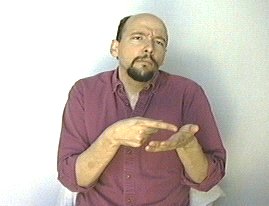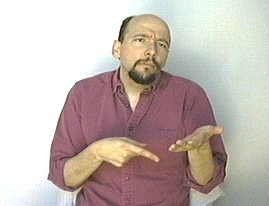There is a facial expression that is sometimes called a "wh-q" expression.
It is the type of facial expression you should use when asking questions that have an
answer other than yes or no. Generally these questions start with the
letters "wh" as do the signs WHO, WHAT,
WHEN, WHERE,
WHY...so you
can see why we call this expression a "wh" question expression.
Expressing the concept of
"WHAT" has more to do with your facial expression than your hands. For
example, if I pointed to my watch and used the "wh-q" facial expression it would mean
that I'm asking you "What time is it?" You've probably already
used this sign many times in your life.
WHAT ("huh" version)
In the picture below I'm doing a general gesture for "what" while using the
WHAT facial expression.
Hold your relaxed "5" hands in front of you. Hunch your
shoulders a bit. Jut your head forward a bit.
Use a WH-Q (wh-question)
facial expression. The hands move slightly forward and to the sides.



Here is a variation of the sign "WHAT" that is made by
extending your base hand outward. Starting near the thumb, drag the tip of your
index finger downward, across your palm.
Note: I don't teach this sign in my "ASL" classes. Instead I use the general
version
(above). But I'll show this other version to you so you'll be able to recognize it if you see
it.
WHAT: (alternate version)


This sign (index dragged across the palm) is valid (and is still used by a significant number of Deaf people) but seems to be waning (becoming used less over time).
Many ASL instructors consider it to be "Signed English." However that simply isn't true. This sign has been around and used by "ASL signing Deaf" since at least 1916 since it appears in "The sign language: a manual of signs: being a descriptive
vocabulary of signs used by the deaf of the United States and Canada" by J. Schuyler Long & Ferdinand A. Moeller.
Imagine yourself asking an older person (perhaps deaf from old age) what time it is.
After he / she /they said "Huh? Speak up!" You'd scrunch up your eyebrows and point to
your watch while saying "What time is it?" The person would most likely understand your body
language and would tell you the time.
Student: Why don't you recommend the alternate version of "what?"
Dr. Bill: It is important to instead learn
to create the meaning of "what" by combining your
facial expressions